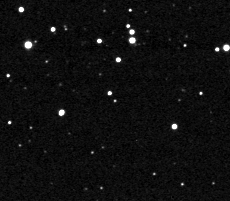(25143) Itokawa

(25143) Itokawa, 7 July 2004

This page reports some photometry of the near-Earth asteroid (25143) Itokawa collected on July 2004 by Gianluca Masi, University of Rome "Tor Vergata" (with the collaboration of Franco Mallia, Campo Catino Observatory), as part of an educational project. To get the images, we used the SoTIE telescope (36 cm, f/7 + AP7) in Las Campanas, working unfiltered. We are particularly grateful to the NASA/TIE team, as well as to Software Bisque, for their support and disposability.
(25143) Itokawa is a very interesting body, being the target of the HAYABUSA (formerly MUSES-C) sample-return mission. In addition, some researches predicted that the YORP thermal effect can be directly detected measuring the increase of its rotation period, a very exciting perspective. This made very important to get photometry of this minor planet during its 2004 favorable, bright apparition. The rock was well visible from the southern hemisphere, this is why we looked at it from Chile.
So far, four-night data were totally collected, covering almost 80% of the phase. Work is in progress to "see" the other maximum too.
(25143) Itokawa orbit
Plot made with TheSky
(25143) Itokawa photometry
The lightcurve above reports all our data available to now. A total amplitude of 1.1 magnitudes was seen during our observing sessions, as expected from a clearly elongated body (see Ostro et al., 2004, for details). The synodic period from the data above is 12.1162 +/- .0005 hours. These data were shared with the people involved with the YORP issue mentioned above.
The plot was made using the ALC program developed by P. Pravec, Ondrejov NEO Photometric Program.
This page will be updated
once new data will be available. Those wishing to use them, are kindly asked
to contact us. Last update:
21 July 2004.